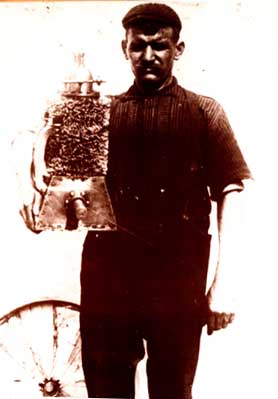|
 |
 ..... This comes at the end of a long, and well-researched article
and sheds some light on reasons why Whitehead has been ignored
for so long... ..... This comes at the end of a long, and well-researched article
and sheds some light on reasons why Whitehead has been ignored
for so long...
For years after their 7 December 1903 flights in North Carolina,
the Wrights were virtually ignored, but after their success in
France on 31 December 1908 brought about a growing conviction
that the aeroplane could be used in war, they were invited to
the White House in 1909. At this time Professor Langley, Secretary
of the Smithsonian Institute, was being hailed by that institution
as the "father of flight".
Samuel P Langley, who had for years been conducting successful
glider experiments, and his assistant C M Manley had been employed
by the government to construct an aircraft that could be used
in war. In late 1903, he launched his creation, the "Aerodrome",
over water but the aircraft was unsuccessful and fell into the
Potomac. Despite this, Langley's position at the Smithsonian was
secure, and very much covetted by the Wrights. Orville Wright,
embittered by the Institution's attitude, lent the "Flyer" to
the London Science Museum for a term of years, thereby bringing
external pressure to bear: the aircraft would not be returned
to the USA until he and his brother were acknowledged as the "Fathers
of Powered Flight". The Smithsonian eventually gave in but Orville
nevertheless extended the period of loan to England through World
War II then intervened to prevent the safe transfer of the "Flyer"
to the US until 1948.
On 23 November of that same year, the executors of Orville Wright's
estate entered into a contract with the Smithsonian for the display
of the aircraft which dealt with, among other - things, the wording
to be used on the accompanying plaque. Paragraph 2 (d) of the
Agreement reads: "Neither the Smithsonian Institution or its successors,
nor any museum or other agency, bureau or facilities administered
for the United States of America by the Smithsonian Institution
or its successors shall publish or permit to be displayed a statement
or label in connection with or in respect of any aircraft model
or design of earlier date than the Wright Aeroplane of 1903, claiming
in effect that such aircraft was capable of carrying a man
under its own power in controlled flight." Failure to observe
this condition by the Smithsonian would result in a return of
the "Flyer" to the vendors, according to paragraph 4 of the contract.
The implication is clear. By trading its integrity for an aeroplane,
the Smithsonian one of the most prestigious public institutions
in the world, was condemning Weisskopf to obscurity. He was after
all, only a humble German immigrant and not one of America's native
sons, regardless of how much he had come to love his adopted home. |
|
 |


![]() he Smithsonian Conspiracy
he Smithsonian Conspiracy ![]()
![]()
![]() ..... This comes at the end of a long, and well-researched article
and sheds some light on reasons why Whitehead has been ignored
for so long...
..... This comes at the end of a long, and well-researched article
and sheds some light on reasons why Whitehead has been ignored
for so long...
![]()
![]()
![]()
![]()
![]()